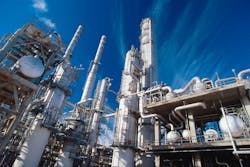To improve chemical production and cut costs, crack the cracker
The cracker furnace is where it all starts in the chemical industry's products value chain. At enormous temperatures, tons of naphtha, light distillate feedstock (LDF), liquified petroleum gas (LPG), ethane, propane or butane are cracked down into ethylene, propylene, mixed C4 and other byproducts, which are in turn used to produce polymers, synthetic rubber and more for applications and processing in wide variety of industries.
The cracker is the keystone species of the chemical ecosystem, and steam cracking is the process step that consumes by far the most energy in the chemicals sector. It accounts for an estimated 260 million tons of CO2 each year — the equivalent output of more than 56 million cars. The cracker has also been a font of uncertainty in realizing desired product yield patterns in different process conditions with varying feedstocks. That uncertainty then propagates through the cracker plant.
A pilot project at one of the world’s largest chemical firms has shed light on the power modern IT can wield in enhancing the predictability of cracking to maximize yields, optimize furnace run lengths and lower operations cost. In an industry facing pressures from raw-materials price increases and volatility to belt-tightening customers, that is good news.
The pilot showed the promise of improved chemical-operations planning based on a deep understanding of the cracker’s behavior. It also demonstrated the benefits of integrating that intelligence with logistics, finance, procurement and other business systems. Taken together, let’s call it “cracking the cracker.”
Nonlinear challenge
The lack of certainty surrounding the cracker has largely had to do with the nature of this beast. Variability is the norm — and, crucially, that variability is nonlinear.
Temperature and other operating parameters affecting the cracker’s operation generally don’t translate into easily predictable (that is, linear) changes in yield. The interplay of a dizzying number of variables is why. You have different feedstocks and their characteristics (such as naphtha paraffin content). You have storage constraints that affect input volumes and intermediate-products storage. You must maintain different temperature profiles in various zones in a furnace based on feedstock being cracked. You have recycle streams (like ethane recycle) cycling back into the cracking furnaces. And, poignantly, you have a continuous flow of massive amounts of cracked products. (The chemical plant where I once worked had, at a given moment, 300 tons of product in varying stages of processing.)
The chemical industry is aware of all this. I have seen many a multidimensional spreadsheet attempting to bring order to the chaos. Advanced process control systems are a big step beyond spreadsheets, but they tend to be similarly myopic in focusing solely on the cracker process control and leaving the rest of the process — and the business impacts — to others.
The right tool
The cracking-the-cracker pilot addressed all this in a few ways, but the crux was to strike the nail of a nonlinear problem with the hammer of nonlinear polynomial optimization. The cloud-based solution considered four feedstocks, six cracker-furnace types, and nine furnace parameters with the aim of establishing optimal yields for the products emerging from those crackers. It had to do cracker optimization all that really fast — in sub-second runtimes — to enable downstream planning processes in real-time.
Given energy costs and the carbon impacts of chemical production in general and cracking specifically, every degree of heat matters, too. One of the pilot’s key benefits was its ability to optimize for temperature given a particular feedstock and set of cracker-furnace variables.
The pilot didn’t stop with the cracker. The project extended into production planning for the butadiene distillation process. That considered tank-farm storage capacity, inventory and feedstock specifics (for example, whether processing in-house-produced mixed C4 with imported mixed C4) to arrive at an optimized daily production plan for butadiene and its byproducts. This helped to formalize product quantities for scheduling their transport via rail, truck and barge.
The ability to integrate these new insights into business systems opened the door to more intelligent production planning and scheduling, transportation management and yard-logistics management. Being able to compare production estimates with actuals helped refine cost estimation on the front end and ensured that customers were getting the products they ordered when they expected them.
Taken together, cracking the cracker imbued cracking and other chemical-production processes with a rare — and welcome — degree of predictability. It showed the power of digitalization in chemical production. And, when implemented broadly, it promises to help chemical producers improve their bottom lines with an eye on sustainability while better serving their customers.
Manoj Narang is Solution Manager in SAP IBU Chemicals. He is based at SAP Labs in India.
About the Author
Manoj Narang
Solution Manager in SAP IBU Chemicals
Manoj Narang is Solution Manager in SAP IBU Chemicals. He is based at SAP Labs in India.
